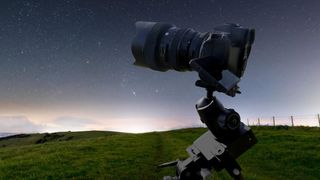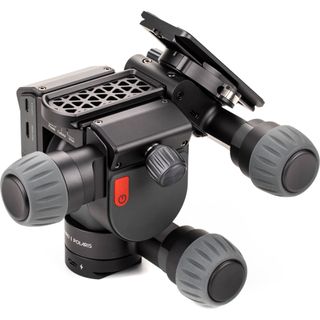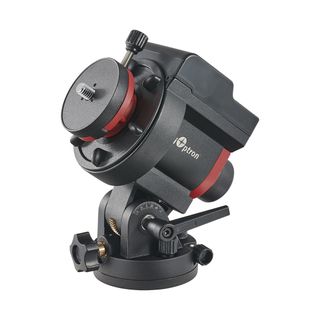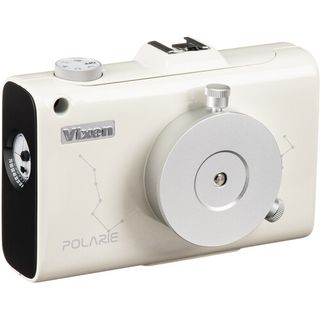Best star trackers for astrophotography 2024
The best star trackers enable you to shoot mega long exposures by tracking the Earth's rotation, helping you capture clear, crisp and detailed astro shots.

1. The list in brief ↴
2. Best overall
3. Best for deep sky astro
4. Best for mid-weight setups
5. Best for battery life
6. Best for small setups
7. Best star trackers FAQ
8. How we test
Investing in one of the best star trackers is a smart purchase for anyone keen on taking clear, long-exposure photos of the night sky without blurry star trails ruining the image. These nifty devices typically attach between your tripod and camera, syncing with Earth's rotation to keep your camera still as the night sky moves. You'll see the difference right away when taking photos with exposures longer than roughly ten seconds — the star tracker ensures you capture crisp stars and stunning galaxies with precision.
To assist you when choosing the best star tracker, we've gathered mini-reviews so you can compare them against each other. It's important to consider the weight of your equipment to ensure they're compatible with the star tracker's payload capacity. Rest assured, all the star trackers listed have undergone thorough testing by expert reviewers, guaranteeing their quality and performance.
If you're new to astrophotography, check out our guide to astrophotography for beginners. And if you're looking to build or upgrade the rest of your kit, we also have guides to the best cameras for astrophotography, the best lenses for astrophotography and the best tripods.
The quick list
Below we've summarized our top picks of the best star trackers for astrophotography available out there, including their main characteristics. If you want more in-depth information, click the links to read more below.

Best overall
The Benro Polaris is our top pick, but it's incredibly expensive. It's waterproof, has a huge-capacity battery and even has a built-in camera interface controller.

Best for deep sky astro
For deep sky astro, this is the one you want. It can hold high payloads so it's great for the heavier lenses needed for deep sky viewing, or even a small telescope.

Best for mid-weight setups
The SAM gives excellent tracking and has a compact and lightweight design, but it's let down by one thing — its poor app.

Best for battery life
Offers a whopping 24 hours of battery life, ideal for long nights of shooting. It's affordable, compact and lightweight, but it lacks ultimate precision.

Best for small setups
This lightweight star tracker is best suited to the lighter payloads of up to 5.5 lbs you'll often encounter with mirrorless systems, though it does also have a short battery life.
Best star trackers for astrophotography we recommend in 2024
Why you can trust Space.com
Best overall

Benro Polaris
Our expert review:
Specifications
Reasons to buy
Reasons to avoid
✅ You have heavy kit: It can support payloads of up to 15 lbs/7 kg, which is the most on this list — certainly more than enough for most setups.
✅ You want something lightweight: Despite its ability to support heavier payloads, it weighs only 3.3 lbs/1.5 kg, which is unusual for star trackers.
❌ You don't have a big budget: This is incredibly expensive, so only really accessible to those who have big budgets.
🔎 Benro Polaris: The star tracker to end all star trackers, our only criticism is the high price tag, which is to be expected with the amount of tech that this little device has in it. It's lightweight but still carries heavier payloads, and offers excellent star tracking capabilities. ★★★★★
The Benro Polaris is more of an electronic tripod head than a traditional star tracker, but its cutting-edge technology means that it has even more on offer as a result. It's controlled via the Benro Polaris app on your smartphone, which allows you to set up the alignment, adjust photo compositions and operate the shutter remotely. It also features auto-tracking functions, meaning you can set it to take automatic panoramas of the Milky Way, for example.
In addition to its advanced technology, the Benro Polaris boasts the highest payload capacity among the star trackers we've reviewed, supporting up to 15 lbs (7 kg) of camera and lens gear. Unlike many other high-capacity star trackers, you won't need to sacrifice the weight of your equipment in your bag, as the device itself remains lightweight at just 3.3 lbs (1.5 kg).
The powerful motors in this star tracker ensure reliable performance, and it comes with a large 2500 mAh battery that keeps you shooting for extended periods. Plus, you can conveniently charge it using a USB-C cable. With an impressive IPX6 waterproof rating, it's built to withstand various weather conditions. However, it comes with a hefty price tag of around $1000, which will likely be too expensive for many photographers.
- Benro also produces some of the Best tripods
| Attributes | Notes |
|---|---|
| Design | Excellent build quality. |
| Performance | Can adjust photo compositions remotely. |
| Functionality | Cutting-edge tech with auto-tracking functions. |
Best for deep sky astro

iOptron SkyGuider Pro
Our expert review:
Specifications
Reasons to buy
Reasons to avoid
✅ You do a lot of deep sky astrophotography: This star tracker is specifically designed for bigger payloads and longer exposures that come with photographing far-away objects.
❌ You want something lightweight: It weighs 3.2 lbs/1.45 kg by itself, and as it requires a counterweight, that adds an additional 3 lbs/1.35 kg.
🔎 iOptron SkyGuider Pro: The perfect star tracker for shooting deep sky objects, this option is specifically designed for heavy payloads — you could even use a small telescope with it. However, it's expensive and not particularly lightweight. ★★★★½
If your focus is on capturing deep-sky objects using big telephoto lenses, the iOptron SkyGuider Pro is an excellent choice. It's specially made to handle heavier gear, supporting up to 11 lbs (5 kg) of equipment. It's more budget-friendly compared to the Benro Polaris, but it achieves this by including a counterweight, which adds about 3 lbs (1.35 kg) to your camera bag. With this impressive load capacity, you can even mount a small telescope to it.
We think you get a lot for your money with this star tracker. It comes with a removable alt-azimuth base with a bubble level and degree markings, along with a quick slew mode (144x) that works in forward and reverse to help you quickly reframe your shots when needed.
Setting up the electronic polar finderscope is very straightforward with the iOptron Polar Scope app on your smartphone. Additionally, it provides four tracking speeds (full-speed, half-speed, Moon and Sun tracking) that work in both the northern and southern hemispheres.
Our only minor concerns were that the wedge occasionally lacks precision, and you'll need to utilize the Declination mount to attach a counterweight to achieve the highest payload levels. However, considering the price, this would still be a solid option for anyone requiring a mount for heavier equipment.
- Learn how to view and photograph comets in our comprehensive guide
| Attributes | Notes |
|---|---|
| Design | Designed for bigger payloads. |
| Performance | Best for deep sky objects. |
| Functionality | Requires counterweight. |
Best for mid-weight setups







Specifications
Reasons to buy
Reasons to avoid
✅ You want exposures up to 4 minutes: For those long nights of shooting long exposures, SAM is a great choice.
✅ You don't have a super heavy setup: The SAM can support up to 3kg, which is more than enough for most mirrorless setups.
❌ You want a reliable app: We noted in our review that the app would often crash and was overall quite bad.
🔎 Sky-Watcher Star Adventurer Mini It's easy to use and one of the most accurate, most versatile and best value star trackers on the market. However, it's got one major weakness — its poor app. ★★★★
The Sky-Watcher Star Adventurer Mini, also known as 'SAM', offers great value as a star tracker. It combines portability with high accuracy, supporting up to 6.6 lbs (3 kg) of equipment. It's lightweight and compact enough to carry in your camera backpack, perfect for taking to darker, less light-polluted areas for your astrophotography shoots.
In our Sky-Watcher Star Adventurer Mini review, we found this star tracker fairly easy to set up and it produced great results once it was up and running, giving us pin-sharp stars during tracks of up to four minutes.
The 'Pro Pack' we reviewed includes various accessories like an equatorial wedge, a ball-head adapter and a polar scope for aligning the mount. However, you'll need to provide your own ball-head for the camera. It operates on two AA batteries, but considering they lasted only three nights of extended shooting, it's advisable to connect it to a portable battery using the micro-USB port.
The main drawback of this star tracker is its SA Console app. Whenever we used it, it had a habit of disconnecting a lot, and sometimes it just stopped working altogether, which was disappointing given the tracker's price. Despite this issue with the app, the SAM remains one of the best star trackers available.
| Attributes | Notes |
|---|---|
| Design | Compact and lightweight. |
| Performance | Reliable tracking, but app is very bad. |
| Functionality | 3kg payload. |
Best for battery life

iOptron SkyTracker Pro
Our expert review:
Specifications
Reasons to buy
Reasons to avoid
✅ You're on a budget: While it isn't cheap by any stretch, for what it is, we think it's a very reasonable and affordable price.
✅ You do long shooting sessions: The internal battery boasts an impressive 24-hour runtime, perfect for long nights of shooting.
❌ You focus on deep sky nightscapes: Wide-angle nightscapes is where this star tracker excels, so if your main interest is deep sky objects, there are better star trackers suited for that.
🔎 iOptron SkyTracker Pro: An affordable star tracker with impressive battery life, a compact and lightweight design and it can track a variety of celestial objects. ★★★★
The iOptron SkyTracker Pro is a great option for beginners or those on a budget since it's cost-effective and quick to set up, while still offering everything you need from a basic star tracker.
It's got a lower payload than the iOptron SkyGuider Pro, taking up to 6.6 lbs (3 kg) of equipment, so it's better suited to wide-angle nightscapes than the deep space shots that require heavier telephoto lenses. But that also means that it's lighter, at only 2.5 lbs (1.1 kg), so it's very easy to travel with and takes up very little space in your camera bag.
This star tracker includes a half-speed mode which is useful for shooting time-lapse photos, and it can track the Moon and Sun separately. Setting up the star tracker is fast and simple, making it perfect for spontaneous shooting sessions when the weather suddenly clears up.
We were pleasantly surprised by the battery's performance, delivering up to 24 hours of usage on a single charge. This ensures you can shoot throughout the night without worrying about battery life. Additionally, it comes with useful accessories such as a counterweight and declination bracket, enabling you to increase its payload capacity when using heavier gear.
- Take a look at the best camera backpacks to keep your kit safe while traveling
| Attributes | Notes |
|---|---|
| Design | Compact and lightweight. |
| Performance | Impressive 24 hour battery life. |
| Functionality | Offers Sun and Moon tracking. |
Best for small setups

Vixen Polarie Star Tracker
Our expert review:
Specifications
Reasons to buy
Reasons to avoid
✅ You have a lightweight setup: It can only hold loads of up to 5.5 lbs/2.5 kg, so lighter setups are ideal here.
❌ You want to do a lot of long exposures: It only has a short two-hour battery life, which will be fine for many circumstances, but if you plan on long nights of shooting you'd need a separate power bank.
🔎 Vixen Polarie Star Tracker For astrophotographers who only have a lightweight setup and don't need to use it for hours at a time, it's a decent option. ★★★
As one of the lightest star trackers featured, the Vixen Polarie is an excellent choice for photographers using lighter equipment who prioritize portability. Its standard load capacity of up to 5.5 lbs (2.5 kg) can accommodate most mirrorless or DSLR cameras with wide-angle lenses, though it may not support larger telephoto lenses. However, there's an extensive upgrade kit available, which includes a counterweight to boost the payload capacity to 14.3 lbs (6.5 kg), along with other useful accessories like a dovetail mounting block, dovetail slide bar and an updated polarscope.
The Vixen Polarie can track the Sun and the Moon, as well as offering a half-speed option for capturing timelapses at night. The battery life is relatively short at only two hours, so we'd recommend connecting it to a portable power bank via the micro-USB if you're planning a longer shooting session.
One thing to note is that you'll need to align this start tracker manually using the supplied compass, built-in latitude meter and polar sight hole. This means that you'll need to be confident in locating Polaris and/or the south celestial pole, although there is a red light and a Vixen PF-L Assist app to help you with this. Check out our guide to locating the North Star if you need any further tips and pointers.
- Check out the Zendure SuperTank Pro power bank which is perfect for power-hungry astronomers
| Attributes | Notes |
|---|---|
| Design | Compact size. |
| Performance | Small payload and battery life. |
| Functionality | Tracks Sun and Moon. |
Frequently Asked Questions
What is a star tracker in photography?
A star tracker is a small, motorized mount that sits between a camera and a tripod. The star tracker rotates the camera in synchronous with the Earth. This prevents star trails that would otherwise be captured during long exposures of the night sky.
Star trackers are useful for a variety of scenarios. Whether taking astrophotographs of the Milky Way with a wide-angle lens or using a telephoto lens to image deep sky objects such as nebulas, galaxies, star clusters and more.
What should I look for in a camera star tracker?
Not all star trackers are built the same. While they all sit between your tripod and camera, most vary in size, weight and design.
The most important implication of this is that different star trackers can handle different payloads (in other words, the weight of your combined kit), so depending on how heavy your camera and lens are, you'll want to choose your tracker wisely.
Additionally, some star trackers work well for telephoto lenses pointed at specific targets, while others are best suited for shorter wide-angle lenses (used for capturing the Milky Way, for example).
As well as the payload capacity, star trackers' accuracy varies between models and brands. More premium models will cost you more but will also deliver much more accurate images.
What is the best star tracker I can buy?
We think the Benro Polaris is the best star tracker overall because it's easy to align, has a camera interface controller and has excellent build quality. However, it is also the most expensive.
For those with a tighter budget, we'd recommend the iOptron SkyGuider Pro, which can accommodate a heavy payload of up to 5 kg, is suitable for deep sky astrophotography, and will be more than powerful enough to cope with long, telephoto lenses.
Do I need any other camera accessories before using my star tracker?
Before taking your first astrophotograph with a star tracker you will need: A camera, lens, tripod and tripod head. Ideally, you'd also use a remote shutter release or intervalometer to trigger the camera without having to touch it, as this will prevent camera shake blur. There may also be other camera accessories like a headlamp or power bank that can help.
What is a star tracker's maximum payload?
The maximum payload of a star tracker is how much weight it can reliably support. This would be the combined maximum weight of your camera, lens and any camera accessories in use like a tripod head.
However, you'll also want to assess the load-bearing ability of your tripod, to check if it can cope with the weight of all the gear plus the star tracker. If in doubt, go for bigger capacity mounts because as a rule of thumb, it's best to have your rig's total weight about half the capacity of the mount.
How we test the best star trackers for astrophotography
To guarantee you're getting honest, up-to-date recommendations on the best star trackers for astrophotography to buy here at Space.com we make sure to put every star tracker through a rigorous review to fully test each instrument. Each star tracker is reviewed based on a multitude of aspects, from its construction and design, to how well it functions in the field.
Each star tracker is carefully tested by expert staff or knowledgeable freelance contributors who know their subject areas in depth. This ensures fair reviewing is backed by personal, hands-on experience with each star tracker and is judged based on its price point, class and destined use.
We look at how easy it is to set up, whether the star tracker mounts are reliable and quiet, if a star tracker comes with appropriate accessories and also make suggestions if a particular star tracker would benefit from any additional kit to give you the best astrophotography experience possible.
With complete editorial independence, Space.com are here to ensure you get the best buying advice on star trackers, whether you should purchase an instrument or not, making our buying guides and reviews reliable and transparent.
Join our Space Forums to keep talking space on the latest missions, night sky and more! And if you have a news tip, correction or comment, let us know at: community@space.com.
Get the Space.com Newsletter
Breaking space news, the latest updates on rocket launches, skywatching events and more!

Jamie is an experienced science, technology and travel journalist and stargazer who writes about exploring the night sky, solar and lunar eclipses, moon-gazing, astro-travel, astronomy and space exploration. He is the editor of WhenIsTheNextEclipse.com and author of A Stargazing Program For Beginners, and is a senior contributor at Forbes. His special skill is turning tech-babble into plain English.
- Kimberley LaneContributing writer